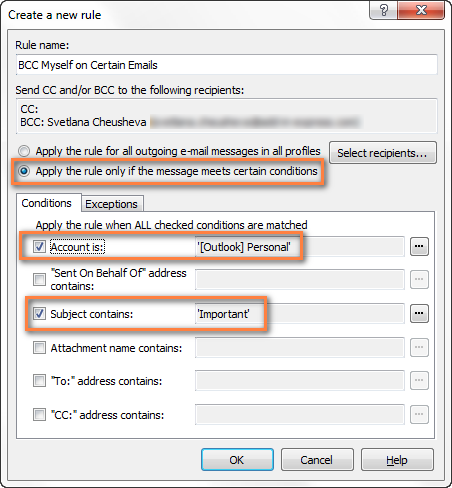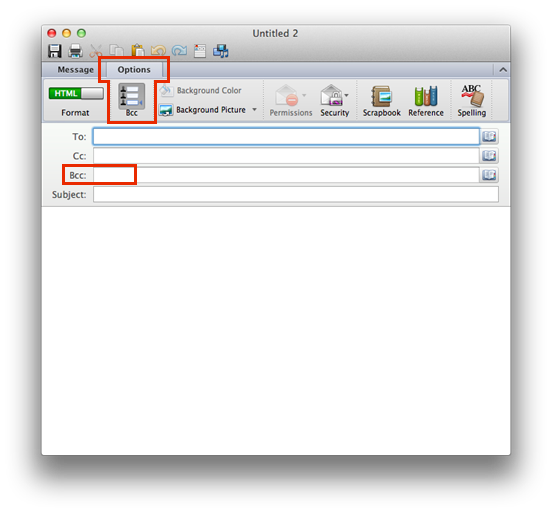
Once the Settings tab has opened, select ‘View all Outlook settings’ which can be located at the bottom of the screen.Īs an example, I have added the name ‘Automatic BCC’. Step by step process of Creating a new rule to automatically BCC or CC yourself into emails:įor the purpose of this tutorial, I will be singing into Outlook 365 using an example account. For example, from the list of exceptions if you select ‘subject includes’ and then add a specific keyword, You will not be sent emails that include that word within the email subject. Outlook 365 allows you to do this by filtering through your emails in your selected method. This is where you can select a situation in which you do not want the email to automatically BCC or CC you into an email. In this context, exceptions can be thought of as the opposite of adding conditions. When creating a new rule to automatically BCC or CC yourself into your emails, there is also an option to add exceptions. Then click ‘Save’ at the bottom of the window.Click in the box and select ‘Inbox’ from the drop down list. In the third box where it says ‘Add an action’, select ‘Copy to’.In the second box where it says ‘Add a condition’, select ‘Apply to all messages’ from the drop down list.In the first box, add a name for the rule.Then, from the column next to it, select ‘Rules’.From the left hand side column, select ‘Email’.At the bottom of the window, click ‘View all Outlook settings’.Sign into your Outlook 365 account and got to ‘Settings’ on the right hand side of the top panel.Creating a new rule to automatically BCC or CC yourself into emails: In order to avoid such issues, this blog post will outline a step by step tutorial on how you can create a new rule for your inbox to allow you to automatically BCC or CC yourself into emails that you send. This can be one of the reasons why following up an email is so easily forgotten by many people, which often leads to problems down the line. Although many people understand that adding your own email address as BCC is a practical way of keeping your emails in order, it is often overlooked when sending important emails. This works especially well if you want to remember to follow up a certain email. Sending meeting details as the email body.Many people have found that BCCing or CCing yourself into emails that you send can be one of the most useful things to do in order to stay on top of all your emails. Now a new message will be automatically created with all the details added in the message itself, including the attendee list. If you want the invitation list to be included as well, then you can drag and drop the meeting onto the Mail Navigation button or a mail folder. The recipient can open the attachment to review the meeting details and choose if he/she wants to add it as an appointment to his/her own calendar. In this message you can specify the Cc and Bcc entries. Now a new message will be created with the meeting attached as an ics-file. Meeting tab-> expand the Forward button and choose Forward as iCalendar

Once created, select the meeting and choose: Forward as iCalendarįirst, create the meeting like normal and close it.

You cannot do this with a single email, but there are 2 convenient methods in Outlook which will quickly allow you to do this and automatically add the meeting details to the message. When setting up a meeting, can I add people to a Cc or Bcc field who will receive the meeting details for informational purposes?


 0 kommentar(er)
0 kommentar(er)
